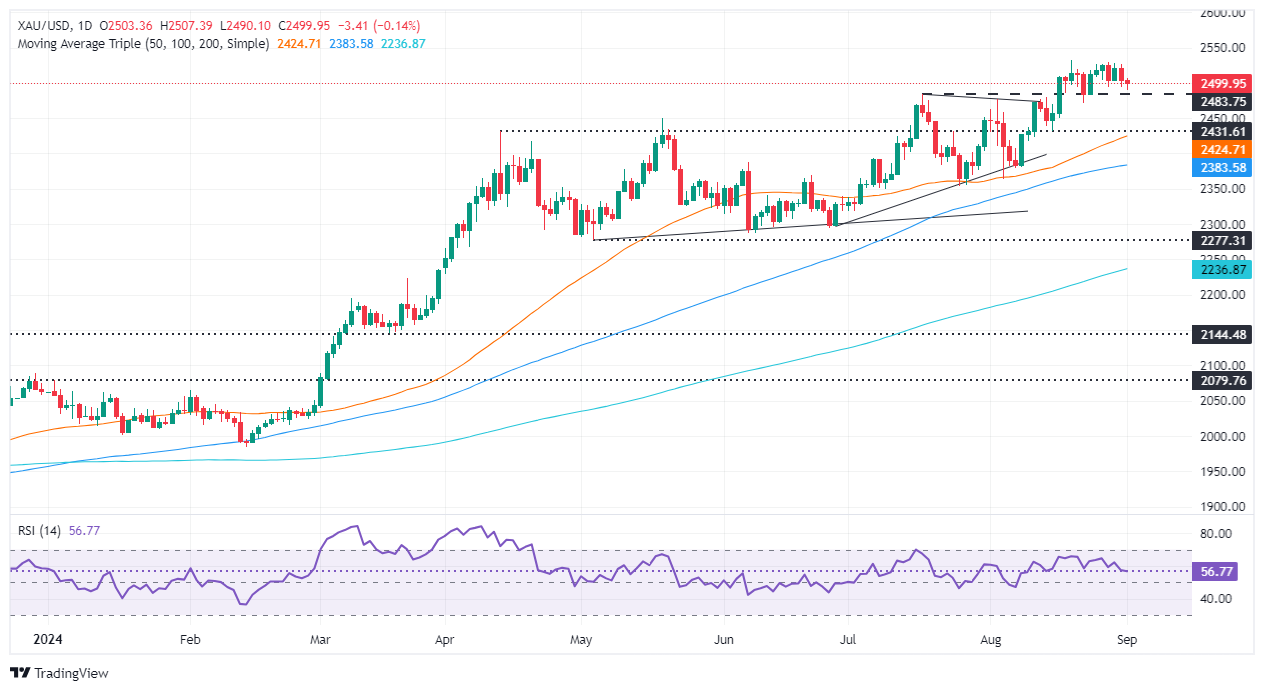- Gold prices fall during a quiet North American session with US markets closed for Labor Day.
- Upcoming US economic reports — ISM PMIs, JOLTS job openings, ADP Employment Change, and Nonfarm Payrolls — set to influence Fed rate decision.
- Fed Chair Powell at Jackson Hole noted that inflation was easing but increasing employment risks, raising recession concerns.
- Geopolitical tensions linger as President Biden may propose a ceasefire deal between Israel and Hamas, potentially affecting markets.
Gold prices dipped during the North American session amid thin volumes due to US markets being closed during Labor Day observance. Conversely, the Greenback remains firm as traders brace for a jobs report that could influence the Federal Reserve’s decision on the size of September’s rate cut. The XAU/USD trades at $2,499, down by 0.14%.
The US economic docket will be busy this week with the release of the Institute for Supply Management’s (ISM) Manufacturing and Services PMIs, JOLTS job openings, the ADP National Employment Change, and the Nonfarm Payrolls (NFP) figures.
During his speech at Jackson Hole, Federal Reserve Chairman Jerome Powell commented that the risks of inflation are skewed to the downside, while the employment risks are tilted to the upside.
Last Friday, the Fed’s preferred inflation gauge, the Core Personal Consumption Expenditures Price Index (PCE), remained unchanged at around 2.5%, hinting that inflation remains controlled. On the other hand, during the last four NFP reports, the Unemployment Rate has risen from around 3.8% to 4.3%, spurring fears among Fed officials that the labor market could be cooling faster than expected.
That reignited recession fears, which had faded following last week’s solid US data. Initial Jobless Claims fell from their levels in late July, Retail Sales rose sharply, and the economy grew at a 3% pace, according to the second estimate of the second quarter’s Gross Domestic Product (GDP) print.
After the data, Bullion prices drooped as investors bought the US Dollar on waning recession fears.
Despite this, geopolitical risks loom even though US President Biden is considering presenting Israel and Hamas a final proposal for a hostage release and ceasefire in Gaza deal later this week, according to Axios sources.
Daily digest market movers: Gold price traders await busy US economic calendar
- ISM Manufacturing PMI for August is expected to improve from 46.8 to 47.8. The Services PMI is estimated to expand from 51.4 to 51.5
- July’s JOLTS job openings are expected at 8.10 million, down from 8.184 million in June.
- Private hiring, revealed by the ADP National Employment Change report, is foreseen increasing from 122K in July to 150K in August.
- August’s NFP figures are expected to rise from 114K to 163K, while the Unemployment Rate could dip, according to the consensus, from 4.3% to 4.2%.
- December 2024 Chicago Board of Trade (CBOT) fed funds future rates contract hints that investors are eyeing 97 basis points of Fed easing this year.
Technical outlook: Gold price set to dive further below $2,500
Gold prices are upwardly biased, though momentum has shifted negatively, as shown by the Relative Strength Index (RSI). Although the RSI is bullish, its slope aims downward, approaching the neutral level. Therefore, in the short term, XAU/USD is downwardly biased.
If XAU/USD drops below $2,500, the next support would be the August 22 low at $2,470. Once surpassed, the next stop would be the confluence of the August 15 swing low and the 50-day Simple Moving Average (SMA) near the $2,424-$2,431 area.
Conversely, if XAU/USD stays above $2,500, the next resistance would be the ATH, and the following resistance would be the $2,550 mark. A breach of the latter will expose $2,600.
Fed FAQs
Monetary policy in the US is shaped by the Federal Reserve (Fed). The Fed has two mandates: to achieve price stability and foster full employment. Its primary tool to achieve these goals is by adjusting interest rates. When prices are rising too quickly and inflation is above the Fed’s 2% target, it raises interest rates, increasing borrowing costs throughout the economy. This results in a stronger US Dollar (USD) as it makes the US a more attractive place for international investors to park their money. When inflation falls below 2% or the Unemployment Rate is too high, the Fed may lower interest rates to encourage borrowing, which weighs on the Greenback.
The Federal Reserve (Fed) holds eight policy meetings a year, where the Federal Open Market Committee (FOMC) assesses economic conditions and makes monetary policy decisions. The FOMC is attended by twelve Fed officials – the seven members of the Board of Governors, the president of the Federal Reserve Bank of New York, and four of the remaining eleven regional Reserve Bank presidents, who serve one-year terms on a rotating basis.
In extreme situations, the Federal Reserve may resort to a policy named Quantitative Easing (QE). QE is the process by which the Fed substantially increases the flow of credit in a stuck financial system. It is a non-standard policy measure used during crises or when inflation is extremely low. It was the Fed’s weapon of choice during the Great Financial Crisis in 2008. It involves the Fed printing more Dollars and using them to buy high grade bonds from financial institutions. QE usually weakens the US Dollar.
Quantitative tightening (QT) is the reverse process of QE, whereby the Federal Reserve stops buying bonds from financial institutions and does not reinvest the principal from the bonds it holds maturing, to purchase new bonds. It is usually positive for the value of the US Dollar.

